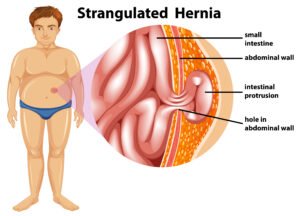Hernia

Hernia occurs when an organ or fatty tissue protrudes through a weak spot or tear in the surrounding muscle or connective tissue.
Here’s an overview of its symptoms, causes, and treatments:
Consulting a healthcare professional, such as a general surgeon, is essential for accurate diagnosis and personalized treatment recommendations tailored to individual needs. By addressing underlying causes and implementing appropriate therapies, hernias can be effectively managed, relieving symptoms and preventing complications such as incarceration or strangulation.
The symptoms of a hernia vary depending on the type and location but may include:
Visible Bulge: A noticeable bulge or lump, especially when standing or straining, which may disappear when lying down.
Pain or Discomfort: Pain or discomfort at the site of the bulge, particularly during physical activity, lifting, or coughing.
Weakness or Pressure: Feeling of weakness, pressure, or heaviness in the abdomen or groin.
Digestive Issues: Difficulty swallowing, heartburn, or acid reflux (hiatal hernia), or bowel obstruction or constipation (intestinal hernia).
Redness or Swelling: Redness, swelling, or tenderness around the bulge, especially if the hernia becomes incarcerated or strangulated.
Weakness in the Abdominal Wall: Weakness or opening in the abdominal wall muscles, which may be present at birth (congenital) or develop over time due to aging, injury, or surgery.
Increased Intra-abdominal Pressure: Activities that increase pressure inside the abdomen, such as heavy lifting, persistent coughing, straining during bowel movements, obesity, or pregnancy, can contribute to hernia formation.
Family History: A family history of hernias may increase the risk of developing one.
Certain Medical Conditions: Conditions that weaken the abdominal wall or increase intra-abdominal pressure, such as chronic cough, chronic constipation, or prostate enlargement, can predispose individuals to hernias.
Watchful Waiting: Asymptomatic or small hernias may not require immediate treatment but should be monitored regularly for changes or complications.
Hernia Belt or Truss: Wearing a supportive device, such as a hernia belt or truss, may help provide temporary relief and prevent the hernia from worsening, particularly in individuals who are not suitable candidates for surgery.
Surgery: Surgical repair (herniorrhaphy or hernioplasty) is the most common treatment for symptomatic or large hernias, involving closing the hernia defect and reinforcing the weakened area with stitches or mesh.

